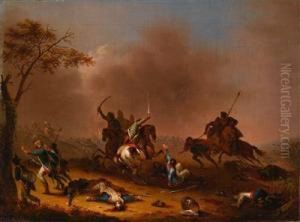Jeremias August Urlaub Paintings
Jeremias August Urlaub was an 18th-century German painter, draughtsman, and engraver, known for his contributions to the Baroque and Rococo periods. Born in 1712 in Würzburg, Germany, Urlaub was part of an era that saw the transition from the grandeur of Baroque art to the more ornate and playful Rococo style, which was characterized by lightness, elegance, and an emphasis on decorative elements. His works, which often incorporated religious and mythological themes, were marked by their detailed execution, vibrant colors, and dynamic compositions.
Urlaub received his early training in his hometown of Würzburg, a city renowned for its rich artistic and cultural scene during the 18th century. He was deeply influenced by the works of contemporary artists and the artistic environment of the Würzburg Court, which was a significant patron of the arts at the time. Despite the scarcity of detailed records about his personal life and professional training, it is known that Urlaub's skills and artistic talents were recognized early in his career, allowing him to establish himself as a prominent figure in the local art scene.
Throughout his career, Jeremias August Urlaub worked on various commissions for churches, noble residences, and public buildings, showcasing his ability to adapt to different subjects and styles. His religious works, in particular, are noted for their emotional depth and the use of light to create a sense of divine presence. Meanwhile, his portraits and mythological scenes reflect the Rococo's fascination with beauty, leisure, and the natural world, often imbued with a sense of playfulness and wit.
Unfortunately, Urlaub's life was cut short when he died in 1759, at the age of 47. Despite his relatively brief career, he left behind a body of work that continues to be appreciated for its artistic quality and historical significance. Today, Jeremias August Urlaub is remembered as a skilled practitioner of the Baroque and Rococo styles, whose works contribute to our understanding of German art during a period of significant transition and innovation.
